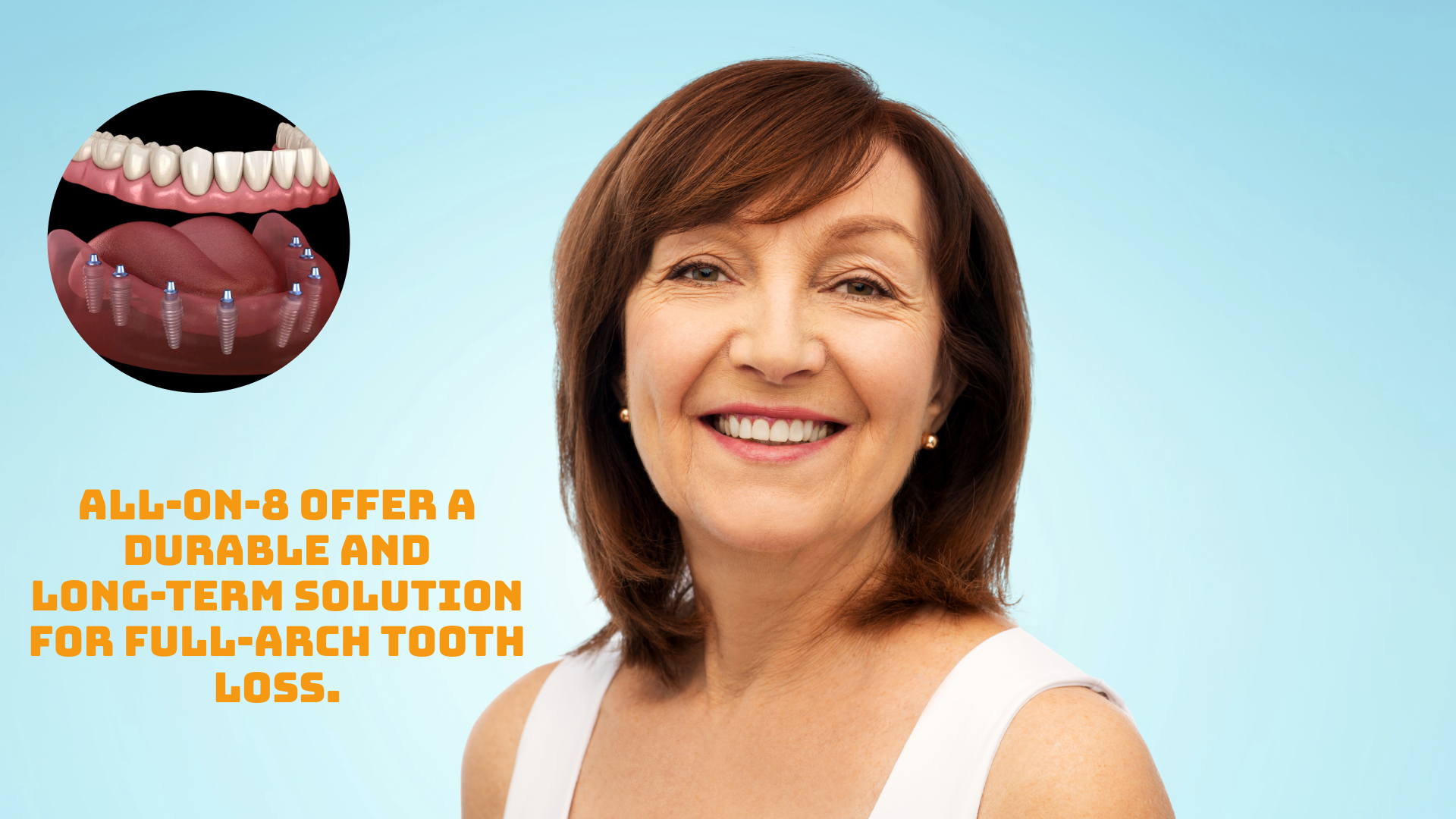
Loss of teeth is not just an aesthetic issue; it can impact chewing, speech, and self-esteem in major ways. One of the most effective solutions to this problem today is All-on-8 dental implant treatment. This system, which is fixed with eight implants, provides more durability, stability, and natural appearance in full jaw prostheses.
But, like any treatment, there are some key factors to consider: is the bone structure sufficient, is the health condition appropriate, and how should aftercare be done? In this post, we will discuss in plain language what All-on-8 is, who it is suitable for, its differences with other systems, its advantages, and potential risks. You will also discover why Turkey stands out in this field.
What Are All-on-8 Dental Implants?
All-on-8 refers specifically to a full arch dental restoration supported by eight dental implants. These implants are metal screw posts that replace the root part of the missing teeth. When more implants (such as All-on-6 or All-on-8) are used, the pressure is distributed more evenly over the implants and jaws, which provides more stability for the permanent prosthesis.
Having more implants, such as All-on-6 or All-on-8, offers a kind of redundancy so that the prosthesis can still provide adequate support in the event of the implant's loss. Having too many implants, though, increases the risk of bridge fracture, which in turn increases the likelihood of issues with the replacement teeth.
Who Is a Suitable Candidate for All-on-8?

Below, we take a closer look at who may be a suitable candidate for All-on-8 dental implants and what should be considered.
1. Ideal Bone Density
In order for the All-on-8 implant treatment to be successful, it is critical that your jawbone has a solid structure. Implants are fixed to the jawbone and form the basis of new teeth. If your bone is too thin or soft, bone grafting may be required first. The ideal dimensions of the bone for this procedure are 4 mm in width and 8 mm in height. As a result, treatment outcomes, particularly for patients experiencing bone loss, are highly dependent on accurate diagnosis and careful planning.
2. Suitability for Upper and Lower Jaws
The number of implants varies according to the patient's bone structure, but generally the more implants used, the more evenly the chewing pressure is distributed and the more robust the prosthesis is. For example, in some patients, personalised planning can be made by placing 8 implants in the upper jaw and 5, 6 or 7 implants in the lower jaw. In other words, the most appropriate and balanced solution is aimed at each patient.
3. Other Issues to be Considered
- Health Conditions Affecting Bone Healing: Healing of the bone around the implant (osseointegration) is critical for success. It is important not to have health conditions that may adversely affect bone healing.
- Uncontrolled Diabetes: Scientific research has shown a positive correlation between uncontrolled diabetes and implant failure. (1)
- Smoking: Smoking makes it difficult for implants to fuse properly to the jawbone because it negatively affects blood circulation and healing. Therefore, the risk of implant failure in smokers is 15.8 percent higher than in nonsmokers.
- Active Infection: The presence of active infection in the areas where implant placement is planned causes the patient to be considered unsuitable for treatment.
- Healthy Oral Tissues: Oral tissues must be healthy for implants.
- Periodontal Disease: Recurrence of periodontal (gum) disease is possible. Patients with severe periodontopathy and advanced bone resorption were included in the case studies, but these patients received the necessary periodontal treatments. Patients with periodontal disease may need more frequent dental visits.
- Recent Chemotherapy or Radiotherapy: Recipients of chemotherapy or radiation therapy who have undergone these treatments within the last twelve months are not eligible for this procedure, according to one study. (1)
- Bruxism: Using a night guard to manage the habit of clenching teeth is important to protect the prosthesis.
- Physical and Psychological Competence: Patients must have the physical and psychological competence to undergo conventional implant surgery.
All-on-8 vs All-on-4 vs All-on-6: Key Differences
Below are the primary ways in which the All-on-8 vs All-on-4 differ from each other.
Implant Placement and Angles
In All-on-X systems, the number of implants is determined according to the density and volume of the patient's jawbone. The All-on-4 technique works with four implants placed at strategic points of the jaw. The anterior implants are placed straight, while the posterior implants are usually placed at a 30-45 degree angle to avoid sinus or nerve structures.
All-on-6 and All-on-8 systems work with more implants, which allows the prosthesis to spread over a larger area along the jaw. Especially when a complete prosthesis of 14 teeth is planned, 8 implants may be preferred.
Stability and Chewing Performance
As the number of implants increases, the pressure during chewing is distributed more evenly and the stability of the prosthesis increases. These systems significantly improve both chewing quality and speech function compared to conventional dentures. Studies show that the vast majority of patients using this type of fixed prosthesis are satisfied with their chewing ability.
Durability
With proper care, Allon-8 implants can last 20-25 years or more. While the loss of an implant in the All-on-4 system can affect the entire structure, the prosthesis can usually continue to be supported in the event of implant loss in the All-on-6 or All-on-8 systems. The implant's position is also vital; if it is lost at the tip, the bridge may need rebuilding.
Cost and Planning
As the number of implants increases, surgical planning and prosthesis design become more complex. If the bone structure is inadequate, bone grafting may be required first, which can increase cost and treatment time. The All-on-4 system is designed to work without the need for bone grafting, usually with angled implants. So, it can reduce time and, in some cases, cost.
Benefits of All-on-8 Dental Implants
All-on-8 dental implants are an aesthetically and functionally effective solution in cases of complete edentulism thanks to the strong support provided by eight implants. This system provides high stability to the prosthesis with balanced implant distribution throughout the jaw, improves chewing function, and gives a natural appearance to the facial structure.
At the same time, the implants integrate with the jawbone, helping prevent bone loss and facial collapse. With proper care and regular checkups, All-on-8 implants can last 20 years or more. In short, All-on-8 is a comprehensive full-mouth restoration that offers both functional comfort and aesthetic appearance in the long term.
Potential Risks and Considerations
Although dental implants in All-on-X systems (especially All-on-8) offer highly successful results, there are some risks and considerations. The most common All on 8 dental implants risks include infection, implant loss, nerve damage, sinus problems, and bridge fractures. Infections, especially around the implant, can lead to bone and gum loss over time.
In addition, if the jawbone is insufficient, bone grafting may be required before the implant, which may increase the treatment time and cost. Systemic diseases such as smoking, diabetes, and poor oral hygiene significantly increase the risk of implant failure. Although the use of a large number of implants theoretically provides extra support to the prosthesis, in some cases it may damage the bridge structure.
Aftercare and Maintenance Guidelines
Regular care is essential for the longevity of fixed full-arch implants such as All-on-8. Brushing twice a day with a soft brush and non-abrasive toothpaste, flossing or water jet cleaning, and using alcohol-free mouthwash are necessary. Avoiding hard, sticky, or acidic foods, limiting smoking and alcohol; and not using the teeth as tools also protect the implants. During the healing process, attention should be paid to soft nutrition, and if problems such as swelling or pain are experienced, the dentist should be consulted.
In addition, it is important to go to the dentist every 3-6 months and have professional cleanings with special tools that do not damage the implants. If there are symptoms such as pain, swelling, odor, or loosening around the implant, the dentist should be consulted immediately. With proper care and regular checks, All-on-8 implants can be used healthily for 20 years and more.
Why Choose Turkey for All-on-8 Treatment?

Turkey is a wonderful option for those looking for affordable and quality dental implants in Turkey. In addition to being much more affordable compared to Europe and the USA, it offers the opportunity to be treated by experienced dentists in state-of-the-art clinics. Especially in cities like Antalya, it is possible to make the process very comfortable with all-inclusive packages that include accommodation, transport, and treatment. You can have a holiday and complete your dental treatment safely.
Conclusion
All-on-8 implant treatment offers a permanent and comprehensive solution to tooth loss, significantly improving the quality of life both aesthetically and functionally. Of course, many factors, such as the condition of the jawbone, general health, and regular care, should be considered for a successful result. However, with the right planning and an experienced team, patients can chew, speak, and smile with confidence again.
It is possible to complete this process both comfortably and safely, especially in countries such as Turkey, which offers both high-quality and affordable treatment opportunities. With more than 20 years of experience, Antlara Dental offers to use its knowledgeable staff to evaluate your expectations.
